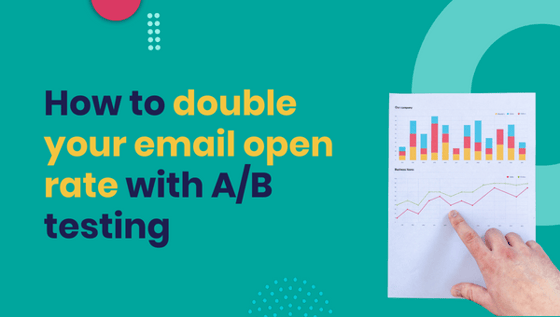


How to double your email open rate with A/B testing in HubSpot





A/B testing is a great way to improve your email marketing results. A/B testing is a data-driven approach to improving your marketing performance, and as a result, you should follow some best practices.
In this blog post, we will walk you through the process of A/B testing your marketing emails. We'll give you tips on defining the goal of your test and choosing the right recipients for your experiment. Plus, we'll show you how to design an effective A/B test! By the end of this post, you'll be an A/B testing expert. Let's get started!
What is A/B testing?
A/B testing, also known as split testing, refers to a randomized experimentation process wherein two or more versions of a variable (web page, page element, etc.) are shown to different segments of website visitors at the same time to determine which version leaves the maximum impact and drives business metrics.
Essentially, A/B testing eliminates all the guesswork out of website optimization and enables experience optimizers to make data-backed decisions. In A/B testing, A refers to ‘control’ or the original testing variable. Whereas B refers to ‘variation’ or a new version of the original testing variable.
The version that moves your business metric(s) in the positive direction is known as the ‘winner.’ Implementing the changes of this winning variation on your tested page(s) / element(s) can help optimize your website and increase business ROI.
The metrics for conversion are unique to each website. For instance, in the case of eCommerce, it may be the sale of the products. Meanwhile, for B2B, it may be the generation of qualified leads.
Testable elements for open rates:
- Number of emails you send to a list
- Subject line
- Preview test
Testable elements for click rates:
- Email body copy
- Email body design
- Email body images
- Email CTA
- Email signatures
It’s important to appreciate that A/B testing isn’t a one-and-done type of activity. It’s an ongoing project of making incremental changes to your page in a bid to fine-tune your campaign for maximum conversions. Every test you run builds upon the test that came before it: even a negative result is useful in that it gives you a better idea of what won’t work when it comes to designing your next test.
Focus on data-driven analysis rather than playing a guessing game.
How to approach A/B testing for marketing emails
Define the goal of your test
While testing your marketing emails, keep in mind that doing something just to do something will not provide valuable results nor provide value to those receiving your emails.
Take a look at how your emails are performing and decide what you want to improve. Maybe a specific email you’re sending is not yielding the results you want. Or perhaps you’re going through a rebranding and want to test different colours or logos. Whatever it is, make sure you have a purpose before setting out to run a test.
When setting this goal for your email test, you’re also preparing to design your email test later on.
Evaluate the segment of recipients you're sending to
Similar to smart content, you need to evaluate to who you are sending specific content. In essence, you need to determine your test subjects.
Unfortunately, You can’t just send the same email to everyone on your list and expect different results. It wouldn’t make sense. You need to figure out who would be best to receive this test email.
You should keep your personas in mind when completing A/B tests. Your content should be targeting a unique persona. Consider testing copy to determine which pain points or goals resonate with that persona.
Design your test
The design will relate heavily to your purpose or goal. Like other aspects of your inbound strategy, your goal is tied directly to the content, purpose, or outcome you’re producing. When you set your goal, you identified areas in your email that need improving. Now it’s time to take that a step further and figure out ways to improve them.
An important aspect of testing is to make sure what you’re proposing is feasible. If you don’t want anyone to unsubscribe from your emails, don’t send ANY emails! Great experiment right? Not so much.
When you’re hypothesizing, be creative but also keep your ideas within the boundaries of reality. You want to explore tests that will provide long-term results for your business.
A/B testing example
In this example, when setting the purpose of your test, let’s say you identified that your newsletter emails are not getting the open rates you’d like and you want to find a solution by running a test to see how you can improve them.
Your goal is to improve email newsletter open rates from 11% to 15% during a business quarter.
Your hypothesis is that the subject lines contain characters and words that are triggering the recipients’ spam filters.
To test this hypothesis, you can design a test to adjust the subject lines to avoid exclamation marks and percentage signs and remove sales-y words like “free” and “discount.” You want to align the subject line closely with what the email contains. And you’ll test if applying those best practices improves your open rate.
Another hypothesis and solution for your low open rates are: You send too many emails, so your contacts are less compelled to open them. So, you design a test to try reducing your email frequency for at least one month and observe if email open rates improve.
This is how you can tie your goal to the design of your test to start to measure and improve your email sends.







